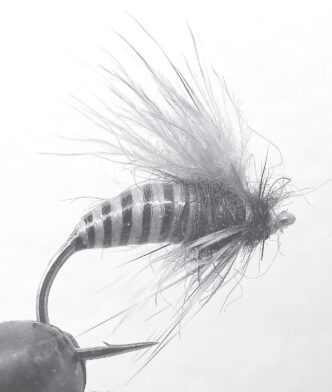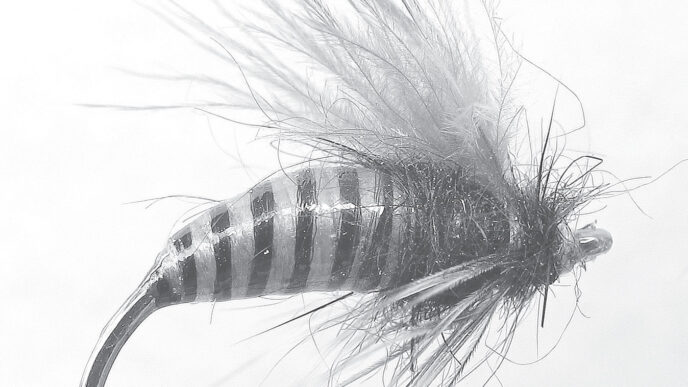My buddy Joe Kelly, the fish biologist, likes to point out the reason why so many guys are disappointed by the Salmon Fly hatch is that it really isn’t a hatch at all. “They show up thinking they’re going to see bugs all over the water — the way they’ve seen the Mother’s Day Caddis or Blue-Winged Olives coming off the river like steam.”
We make our way along the railroad tracks, the river a sparkling promise unwinding through rangeland and pampered green fields. Threatening skies collide and recoil above ridgelines to the south. The sharp scent of sage clings to the breeze as though somebody’s grandmother is cooking nearby.
Joe pauses to watch an angler casting at the bottom of the riprap thirty feet below the stony bed of the tracks. “Only this time they think the bugs’ll be big as hummingbirds — and that the fish’ll feed like teenagers served up Hot Cheetos and Takis.”
Below a bright riffle, bent like a comma before entering a long, wide run beyond, three anglers worry the water with a scramble of lazy loops. “But then the guy shows up, the bugs are in the grass and bushes, and not a single fish is rising. He throws his fly out there, and nothing happens. Barely a bug in the air — and even when he sees one on the water, it floats past undisturbed. What the ? he asks himself. Did he miss it somehow?”
Almost on top of us before I notice him, a guy hurries our way, taking the railroad ties two at a time. There’s a look guys get during Salmon Fly season when, by all rights, they should be crushing fish, but they’re not. For one thing, every other angler is the enemy. This deep into our own shift, I have to believe Joe and I look like a couple of lucky gamblers after a second pass, the morning after, through the all-you-can-eat buffet.
Our friendly hellos fail to check the guy’s gait. Back-lit by tangled gray skies, the fly hung from his rod’s stripping guide offers the suggestion of a gaudy bath toy — or something you might share with a pet ocelot.
“ ’Course, it doesn’t help,” says Joe, turning back to inspect the river, “when he’s fishing with one of those commercially tied abominations — the kind that looks like it’s got a rubber bleep sticking out of its bleep.”
Now, now, Joe.
We turn off the tracks, step through the sage, plunge toward the river. Halfway down the steepest of banks, we’re scrambling for purchase. Yet I can’t really fault Joe for his show of attitude, a tone it’s easy to adopt when, after so many tries, you find yourself whacking big trout during a Salmon Fly hatch that isn’t a hatch at all. A third spell of 80-degree weather since the first of May and, just as the books predict, we’re on the river the same time as the bugs. But of course it’s an emergence, not a hatch, we’re fishing, as Joe keeps reminding me — a distinction, I admit, reaching the bottom of the bank, that can make all the difference in the world.
During the next hour, we’re reminded why. No bugs, as Joe’s said, decorate the water, but they’re thick as leaves in the riverside vegetation, having emerged, as winged adults, from nymphs that crawled out of the river and up onto rocks and exposed roots and driftwood and low-hanging limbs. In a true hatch, claims Joe, adults abandon their nymphal shells while still in the water, the profound, yet laborious transformation that makes them so vulnerable — and desirable — to feeding trout. What we’re doing, instead, is fishing margins of the river next to where adult Salmon Flies, already hatched, now live.
What we’re really doing, of course, is looking for likely places where trout have taken up sneaky lies, ready to devour clumsy Salmon Flies that fall like manna from above.
I get first licks. A sidearm cast bends the leader around a sickly, low-slung branch, landing the fly in trembling shade. I have to bend down and lean forward, as if looking up under a fender, to keep track of the cast as it rides in close to the bank. I can barely see the fly – until it vanishes in a swirl of flesh and color, a fabulous spark that fuses the rod to the awful weight of what seems a truck tire swept by heavy current downstream.
“Don’t even think about chasing it,” says Joe, near me on a patch of bank no bigger than a bathtub, impossible to leave by any route other than the thirty-foot climb by which we arrived.
We end up calling it the Landing Beach. The fish have congregated upstream below a tangle of brush and half-downed willows and cottonwood saplings. A single step off the bank and even Joe, a head taller than I am, would be swimming. I miss two rises the length of my leader off my rod tip. Joe steps up and immediately shows me how it’s done. “Bounced that last cast right off the tree,” he says, making his stand on the Landing Beach as line melts off his whining reel.
All of which proves — what? In a column dedicated to tying flies, let me remind readers that my thesis here remains unchanged: the last thing that matters is your fly. I don’t want to mislead anyone. The secret to a good day of Salmon Fly fishing begins with understanding the insects in question and the manner in which trout generally feed on them. Too many descriptions of Salmon Fly sport make it seem that the trick is finding yourself in the right place at the right time — a suggestion I’ve been guilty of myself. Either that, or the claim is made that you just have to show up with The Right Fly.
So I confess to some of that going on here. Joe’s derogatory remarks about commercially tied Salmon Fly patterns reflect opinions not far from my own. Readers recognize, of course, that I’m an old school tyer, a traditionalist who believes in understated, impressionistic patterns, rather than attempts at hyperrealism, those flies that hook fly-shop customers, but turn out, on the water, to look as lifeless as a carefully embalmed corpse ready for viewing in a silk-lined casket.
Which is only to say I do think flies matter — but only after you get everything else right.
Yet on this occasion, stalking the edges of the river for hidden, surface-gazing trout, I felt I had a pattern that gave me a leg up on the competition, a fly that captured the essential look of the real bug in the bushes and, what is more important, the few we saw on the water. A big fly — I call it Too Big to Fail — it still sat low in the water, yet it remained in the surface film, even after repeated dunkings by hoodwinked fish. The color, the outline, the silhouette all seemed spot on — a conviction that grew stronger each time a trout rose, out of nowhere, and ate the fly just like that.
The right fly? Who’s to say.
But one thing’s certain: it wasn’t the wrong one.
Materials
Hook: Daiichi 2340, 6X-long, Limerick bend, size 6
Thread: Black
Tail: Elk mane
Body: Orange poly yarn
Rib: Brown hackle, undersized
Wing: Moose body hair
Hackle: Brown
Thorax: Peacock herl, dyed red
Tying Instructions
Step 1: Secure the hook and start the thread. Rarely do I call for a hook style that can’t be found on practically every tyer’s desk, but in this case, I insist on the Daiichi 2340 6X-long streamer hook with the relatively narrow-gap Limerick bend. (Oddly, the last pack of size 4 Daiichi 2340 hooks I bought had a classic round bend, and the hook shank itself was virtually the same length as the old 5X-long Mustad 79580.) The 6X-long hook shank gives you the room you need to tie a fly as big we’re after here while at the same time positioning the business end of the hook where it does the most good without adding an anchor’s worth of iron off the aft end of your floating fly.

Step 2: Clip, clean, and stack a tuft of elk mane. Create a short, flared tail just ahead of the start of the hook bend.

Step 3: Select a hackle feather with fibers no longer than the narrow Limerick-bend hook gap. At the root of the tail, tie in the hackle feather by its tip, so that when wound forward, the fibers get longer. For now, move the attached hackle feather out of the way.

Step 4: Secure a length of poly yarn at the same spot you attached the tip of the hackle feather. Depending on the yarn, you may find you first want to unravel a strand for creating a slender, more realistically proportioned body. Advance the thread to a point on the hook shank about one-third of the way back from the hook eye. Wind the yarn forward, creating a smooth, even body. Tie off and clip the excess.

Step 5: Palmer the body of the fly with six to eight evenly spaced winds of the hackle feather. Tie off and clip the excess at the forward end of the body.

Step 6: For the wing, clip, clean, and stack a substantial tuft of moose body hair. Moose offers the best hair I’ve found for creating a long wing that remains close to the body, even when cinched tight to the hook shank. Position the wing so that it extends to the bend of the hook. Secure the forward portion just ahead of the body, adding more wraps of thread to keep the wing from spinning while adding to the profile of the fly’s thorax.

Step 7: Select another hackle feather, this one with slightly longer fibers than those of the feather for the palmered body hackle. At the root of the wing, tie in this new hackle feather by the lower end of its stem, rather than the tip.

Step 8: For the thorax, tie in two lengths of dyed peacock herl just ahead of the root of the wing. Advance the thread to the hook eye. Wrap the peacock herl forward, creating a chunky thorax. Tie off and clip the excess.

Step 9: Wind the thorax hackle feather through the peacock herl with a series of closely spaced wraps. Tie off behind the hook eye and clip the excess. Create a tidy head with wraps of thread (image on page 18). Whip finish and saturate with the head lacquer or head cement.
















